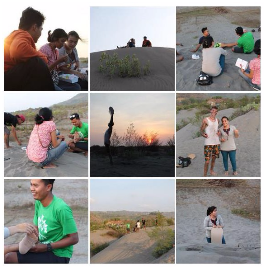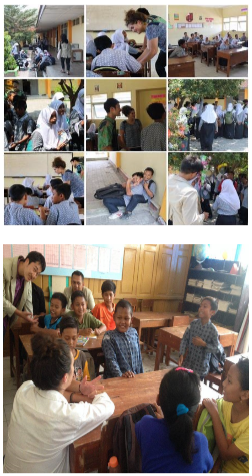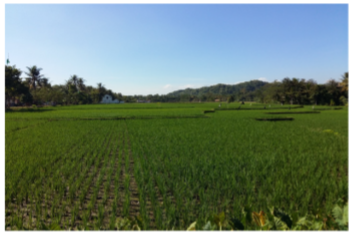For decades Gunung Kidul District in Yogyakarta Province has been suffering from immense drought. Even more, this devastating phenomenon is continuously spreading through 11 sub-districts from a total 18 sub-districts that constitutes Gunung Kidul. Those 11 sub-districts are Rongkop, Paliyan, Panggang, Girisubo, Purwosari, Tepus, Tanjungsari, Nglipar, Patuk, Ponjong, and Ngawen. Local authorities have concluded; the rapidly-subsiding rain water ponds are the cause of this long draught.
In a state of desperation, 8 out of 11 impacted sub districts have appealed for a clean water supply drop from the provincial government. President Joko Widodo has even instructed every head of districts to check his/her area regarding any possibility of drought. However, due to financial and access limitation, supply drops are getting harder and harder to be delivered.
Researchers from Universitas Gadjah Mada have been trying to look for water supply alternatives to help solve the drought problem in Gunung Kidul. It turns out a number of UGM scientists discovered an underground water resource at Plawan Cave, Giricahyo Village, Purwosari sub-district back in 2004. The only problem was, locals couldn’t get to the water source due to the fact that it was located 107 meters below ground level and 2 meters in diameter.


To answer such challenge, Universitas Gadjah Mada commenced a continuous Student Community Service-Community Empowerment Learning (SCS-CEL) program focusing on one main goal: providing a sustainable and manageable water source for Giricahyo Village. Considering the importance of this mission, UGM opened its doors for multiple stakeholder cooperation. Surprisingly not only local stakeholders responded, the international community joins hand in hand to solve this issue. In 2007, foreign students and professors coming from: Hanseo University in South Korea (35 students, 4 professors), Hiroshima Economic University in Japan (33 students, 6 professors), Seoul Women University in South Korea (23 students, 2 lecturers), Chuo University in Japan (4 students), Adger University College in Norway (18 students), and 2 students from Spain and Australia came to Yogyakarta to join UGM’s SCS-CEL program.
The first step is “Water Exploration through Renewable Energy”. A total of 185 students divided into 7 batches of SCS-CEL program, worked together with partners from Ministry of National Education, Ministry of General Works, Institute of Development and Application Technology, local government of Gunung Kidul, and the National Bank Association to undergo this initial task. Observations were conducted using different approaches and instruments to get a comprehensive assessment on the precise location and possible techniques to pump the underground water up and distribute it to the whole village.
Following the observation, SCS-CEL students with cooperation from local residents started the construction of underground pipes which is then accompanied by on ground pipe construction. These pipes will be useful to transport water supply from the underground spring to a reservoir on ground, before being distributed to each house. A hybrid powerplant was built for the pumping system. In it was an electrical generator with 55 Kva power, and solar panels with photo-voltaic module, accumulator, inverter, and a direct-coupling system or storage. To ensure a sustainable supply of water, on ground reservoir was built with a capacity of 60 m3. Water stored in the reservoir will be able to be distributed to 7 villages supported by 26 outlet points.
After water supply was ensured, a problem of management arise. SCS-CEL students held countless lobbying and meeting with residents of seven village community to form a “Water Supply Management Board”. The first step was identification and recognition on local problem and potency which is then continued by the forming of water management organization. Students coming from law faculty also helped in determining legal status for the organization. To ensure the wellbeing of the operation, trainings on management and water supply operation was also held several times.
Until today, the water supply program is implemented according to initial planning. Each year, SCS-CEL students undergo a continuation and development program to further the widespread of water supply from Giricahyo Village to other villages in all 11 drought-impacted sub districts while not forgetting to maintain the reservoir in hand. This successful multiple-stakeholder program is a form of Universitas Gadjah Mada’s commitment to do research and development for the people.

 Through this SCS-CEL UGM program, Charles has learned many things that he did not know before living in the vicinity of UGM. He gained new knowledge and perspective on life, culture, and other positive values that will help him grow as a better and wiser person.
Through this SCS-CEL UGM program, Charles has learned many things that he did not know before living in the vicinity of UGM. He gained new knowledge and perspective on life, culture, and other positive values that will help him grow as a better and wiser person. By the time their SCS-CEL program ends, it is expected that international students will be able to have new knowledge and insights on Indonesian culture, arts, and most importantly a rural community’s day by day livelihood. A cultural exchange will also benefit the local community, as it gives an extensive knowledge on other international communities.
By the time their SCS-CEL program ends, it is expected that international students will be able to have new knowledge and insights on Indonesian culture, arts, and most importantly a rural community’s day by day livelihood. A cultural exchange will also benefit the local community, as it gives an extensive knowledge on other international communities. 


 As one of 17 SDGs (Sustainable Development Goals) key points promoted by the United Nations, ensuring healthy lives and promoting well-being for all at all ages is a very essential step in achieving the totality of goals. According to
As one of 17 SDGs (Sustainable Development Goals) key points promoted by the United Nations, ensuring healthy lives and promoting well-being for all at all ages is a very essential step in achieving the totality of goals. According to  A slight different approach from Mohammad’s sub unit approach, Tim Buettner and Tim Kalmbach’s sub unit decided to organize a football tournament to promote a healthy and active lifestyle for Sidorejo youngsters. The “Bule Cup” took place over four days with contestants coming from four other villages. After losing at the first stage, they then supported the other groups competing for the number one position.
A slight different approach from Mohammad’s sub unit approach, Tim Buettner and Tim Kalmbach’s sub unit decided to organize a football tournament to promote a healthy and active lifestyle for Sidorejo youngsters. The “Bule Cup” took place over four days with contestants coming from four other villages. After losing at the first stage, they then supported the other groups competing for the number one position. Locals also had the opportunity to introduce all three international students to their day by day duties. In the mornings, Mohammad enjoyed the company of several kids as they taught him how to fish traditionally. Tim Kalmbach and Tim Buettner, in the other hand, got the opportunity to learn rice milling process. They were able to observe and participate in each step from drying the paddy to packing them into sacks. This process was especially interesting as they only have packed up rice in supermarkets.
Locals also had the opportunity to introduce all three international students to their day by day duties. In the mornings, Mohammad enjoyed the company of several kids as they taught him how to fish traditionally. Tim Kalmbach and Tim Buettner, in the other hand, got the opportunity to learn rice milling process. They were able to observe and participate in each step from drying the paddy to packing them into sacks. This process was especially interesting as they only have packed up rice in supermarkets.